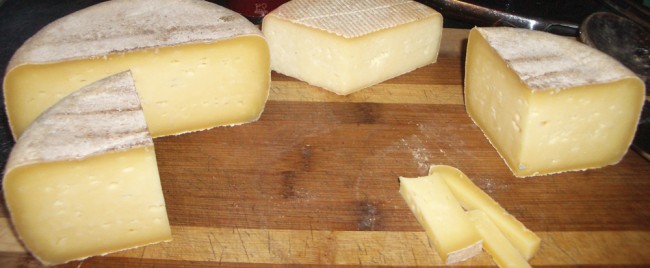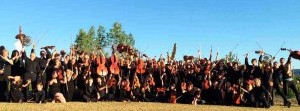
Photo Credit: Lorie Farrell
The Search for Local Cheese Culture
Mmm… smooth, creamy, stinky cheese. Humans have been making cheese for almost as long as they have been domesticating animals, which archeological evidence shows is at least 5,000 years. Before refrigeration was available, making cheese was a way of creating a food high in calories and protein that was easy to store and transport.
Cheese, bread and wine make up the Holy Trinity of food. While it is common for people to make bread and wine at home, small-scale cheese makers are a rare and shy breed. The search for local cheese-makers sounds like this:
Open with, “Our mutual friend so-and-so mentioned to me that you make cheese…” to which the prospective cheese maker will likely respond, “Oh. I don’t do that anymore” or “I’m not really the one to talk to, you should call so-and-so” or “Yes… but can I call you back?”
It seems that the first rule of Cheese Club is that you do not talk about Cheese Club. Fortunately, Bulkley Valley resident Patrick Farrell is willing to open up about the delicious food.
“My wife Lorie and I have a little farm and we wanted to be more self-sufficient. We had a goat and I had a book with a small section on making cheese,” he says. The experimenting began in Farrell’s kitchen six years ago at about 11 p.m. “I didn’t really know what I was doing … and the first few cheeses I made were pretty dry.” But the process had him hooked, and he started doing more research.
“The difference between each cheese is the kind of milk used, the temperature you cook the milk at, as well as the starter bacteria and the aging process,” he explains.
Goat, cow and sheep milk are all commonly used for making cheese, and each type has its unique characteristics and flavour. Cow’s milk creates cheese that is more yellow in colour, the curd is firm and the fats separate more easily. Goat’s milk has no carotene, which makes it very white. It is more acidic than cow’s milk, which also makes it ripen faster. Sheep’s milk is different again, having a higher solids content, which means it makes more cheese than the same volume of milk from a cow or goat.
The milk’s flavour can vary between each animal and also depends on what the animal is eating. Farrell notes, “When the cows are in the dandelions the cheese has a strong flavour and when they are eating clover the cheese is sweeter. We now have Dexter cows and the cream in their milk doesn’t separate as easily as other breeds.”
Bacteria are the second ingredient, giving cheese its unique flavour. Historically, storing cheese in caves and earthen cellars was the only option for keeping it at the right temperature while it matured. Different kinds of bacteria and moulds lived in these caves, and would become part of the cheese and give it a flavour and consistency unique to that specific spot.
Penicillium roqueforti is the blue mould that gives stilton, roquefort, danish blue and gorgonzola cheeses their strong flavours and blue-green colouring. Brevibacterium linens is a bacterium common to munster, limburger and port-du-salut, and produces a reddish colouring to the body and rind of the cheese. In modern cheese making, the bacterium is added during the cooking process. The next influence on cheese is how it is aged.
“Fortunately, I have a cold room in the farmhouse. The ideal temperature range for aging cheese is 10 to 14 degrees Celsius with very high humidity. I have a wooden cabinet for cheese aging, and when it is full of cheeses, they give off their own moisture and keep the humidity high within the cabinet,” Farrell says.
As for advice for beginner cheese makers, he says, “Cleanliness is extremely important. Sanitize everything with boiling water. Many of the reasons for cheese going wrong can be traced back to equipment not being sanitized properly.” He also says that it is very important to follow directions and understand why you have to do each step.
“Without understanding the why you may be tempted to take shortcuts that will ultimately make the end product not as good. I would also recommend buying a starter culture. You could use store bought yogurt, but the starter culture is more precise and you will get a more consistent product.”
Farrell adds that his favourite cheeses to make are reblochon or limburger—both especially smelly cheeses.
“It smells bad while it is aging, but when it is done, the cheese has a sweet, nutty flavour. I make brie, swiss and gruyere as well. Appenzellar cheese is my next challenge. There’s a special rub they put on it and I’m trying to crack the secret—of course nobody in the factory will tell what it is,” he says.
Now that Farrell has unlocked a few secrets and perfected his recipes, he is undertaking the process of becoming certified to sell cheese commercially.
“My wife and I work in the mining business and we wanted to have an option to stay home more. We did some research on what it would take to make a business out of cheese making, and have been working towards it for a couple of years,” he says.
Farrell’s permits are in place, and he is converting an existing building on his property to a fully functioning cheese plant—sterilized walls, sealed floors and installed sinks and other equipment to ensure everything meets food safe requirements—in anticipation of the final inspection. He says he hopes to be selling his cheese by summer, with production starting at about 250 pounds (113 kg) of cheese per week. With a raw milk operation, the cheese is required by law to age for at least 60 days.
“This is a very small amount of cheese as far as the industry goes,” says Farrell, but for him it is about creating a local cheese supply. Farrell will start selling at the Bulkley Valley Farmers’ Market and then see if local restaurants and small retail outlets are interested.
“As far as the local food scene is concerned, cheese is the only thing that’s missing,” he says, eager to fill the gap. He’s also keen to share the knowledge and encourage others to start making cheese at home. “I want to hold seminars on how to make cheese, too. I think everyone should make homemade cheese.”






I am in Quesnel BC, we have just relocated here as we are interested in starting a sheep dairy and making cheese. I am finding very daunting with the laws of dairy production and set up. I am looking to only supply my family and local farmers market. Do you have any advice for someone in the set up process??
I would be grateful for any information,
thank-you
sheri
👤 sheri Watt 🕔 Dec 06, 2016